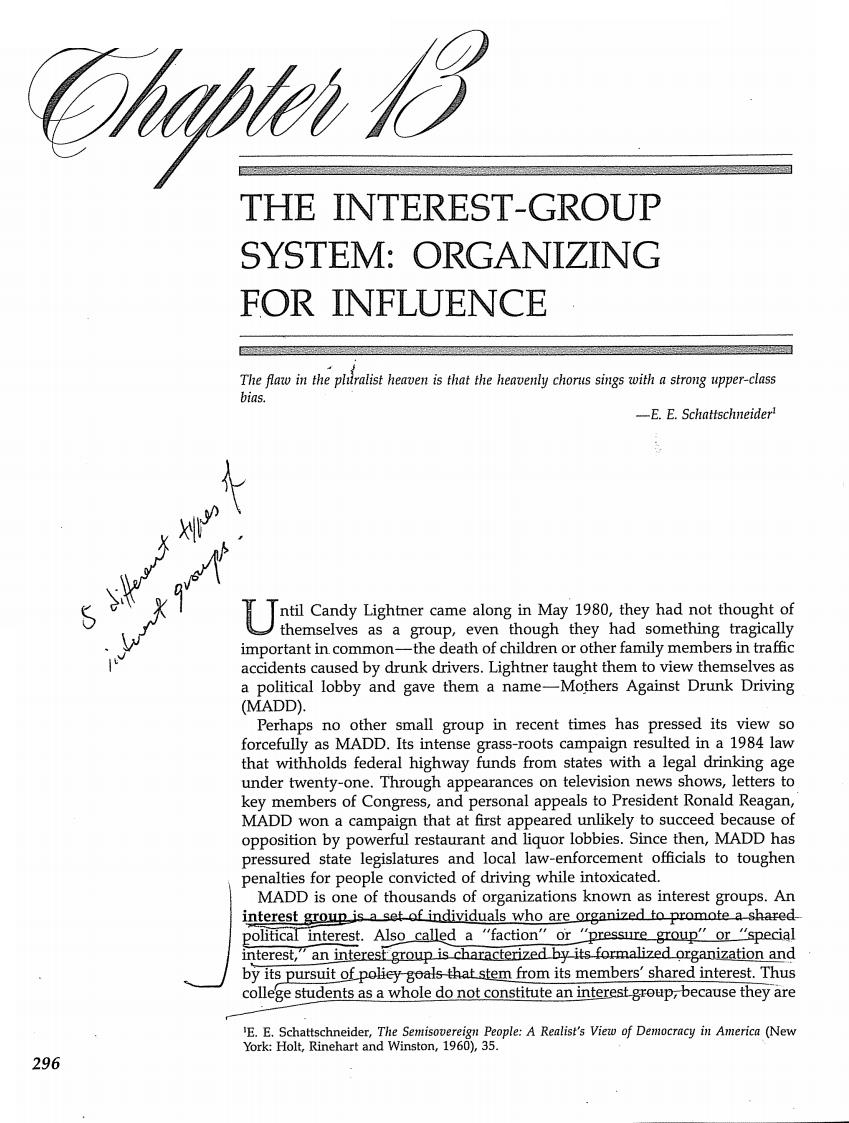
Chgnt B3 THE INTEREST-GROUP SYSTEM:ORGANIZING FOR INFLUENCE The flaw in the pldralist heaven is that the heavenly chorus sings with a strong upper-class bias. -E.E.Schattschneider fi如天 ntil Candy Lightner came along in May 1980,they had not thought of themselves as a group,even though they had something tragically important in common-the death of children or other family members in traffic accidents caused by drunk drivers.Lightner taught them to view themselves as a political lobby and gave them a name-Mothers Against Drunk Driving (MADD). Perhaps no other small group in recent times has pressed its view so forcefully as MADD.Its intense grass-roots campaign resulted in a 1984 law that withholds federal highway funds from states with a legal drinking age under twenty-one.Through appearances on television news shows,letters to key members of Congress,and personal appeals to President Ronald Reagan, MADD won a campaign that at first appeared unlikely to succeed because of opposition by powerful restaurant and liquor lobbies.Since then,MADD has pressured state legislatures and local law-enforcement officials to toughen penalties for people convicted of driving while intoxicated. MADD is one of thousands of organizations known as interest groups.An interest group is a set of individuals who are organized to promote a shared political interest..Also called a“"faction'”or"pressure_group”or“special interest,"an interest group is characterized by its formalized organization and by its pursuit of poliey goals that stem from its members'shared interest.Thus college students as a whole do not constitute an interest group,because they are E.E.Schattschneider,The Semisovereign People:A Realist's View of Democracy in America (New York:Holt,Rinehart and Winston,1960),35. 296
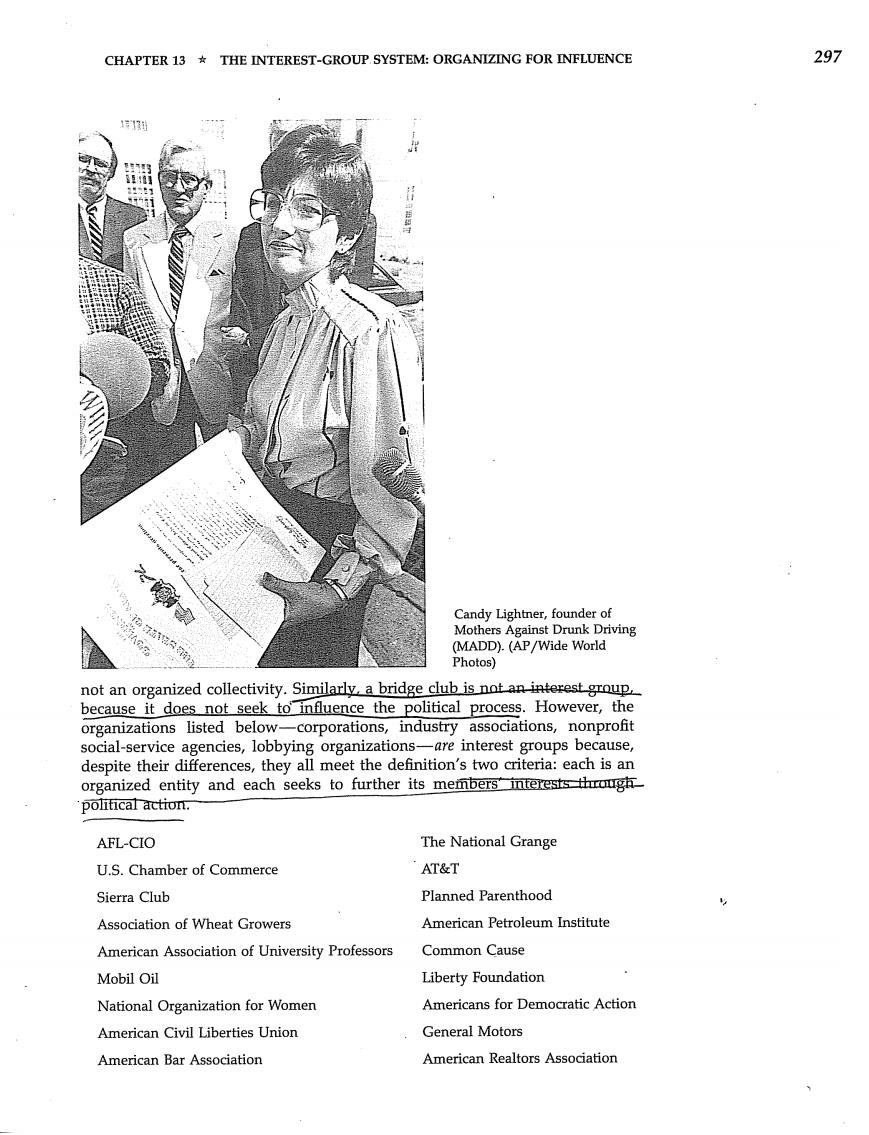
CHAPTER 13 THE INTEREST-GROUP.SYSTEM:ORGANIZING FOR INFLUENCE 297 1号13出 35411 ”17”1 7 Candy Lightner,founder of Mothers Against Drunk Driving (MADD).(AP/Wide World Photos) not an organized collectivity.Similarly,a bridge club is not an interest group, because it does not seek to influence the political process.However,the organizations listed below-corporations,industry associations,nonprofit social-service agencies,lobbying organizations-are interest groups because, despite their differences,they all meet the definition's two criteria:each is an organized entity and each seeks to further its members'interests through political action. AFL-CIO The National Grange U.S.Chamber of Commerce AT&T Sierra Club Planned Parenthood Association of Wheat Growers American Petroleum Institute American Association of University Professors Common Cause Mobil Oil Liberty Foundation National Organization for Women Americans for Democratic Action American Civil Liberties Union General Motors American Bar Association American Realtors Association
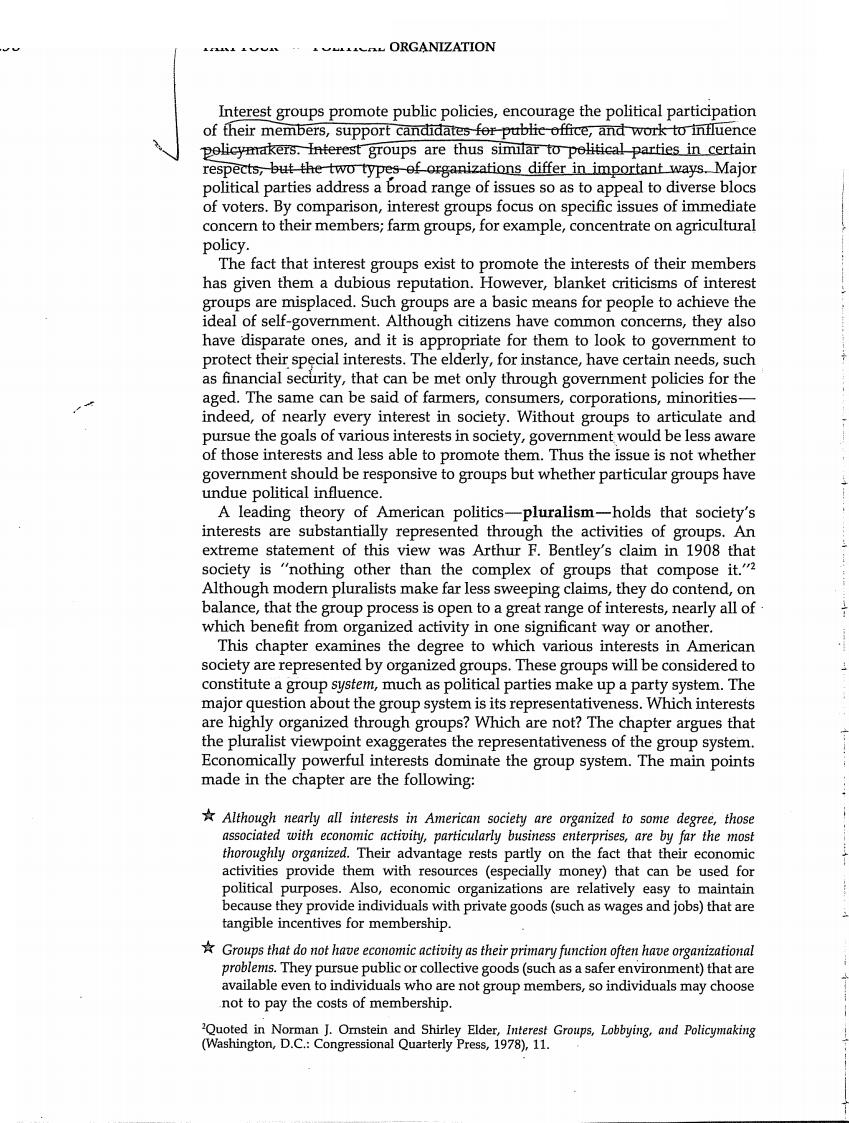
·~ORGANIZATION Interest groups promote public policies,encourage the political participation of fheir members,support candidates fer public office,and work to influence pelicymakers.Interest groups are thus similar to political parties in certain respects,but the two types of organizations differ in important ways.Major political parties address a broad range of issues so as to appeal to diverse blocs of voters.By comparison,interest groups focus on specific issues of immediate concern to their members;farm groups,for example,concentrate on agricultural policy. The fact that interest groups exist to promote the interests of their members has given them a dubious reputation.However,blanket criticisms of interest groups are misplaced.Such groups are a basic means for people to achieve the ideal of self-government.Although citizens have common concerns,they also have disparate ones,and it is appropriate for them to look to government to protect their special interests.The elderly,for instance,have certain needs,such as financial security,that can be met only through government policies for the aged.The same can be said of farmers,consumers,corporations,minorities- indeed,of nearly every interest in society.Without groups to articulate and pursue the goals of various interests in society,government would be less aware of those interests and less able to promote them.Thus the issue is not whether government should be responsive to groups but whether particular groups have undue political influence. A leading theory of American politics-pluralism-holds that society's interests are substantially represented through the activities of groups.An extreme statement of this view was Arthur F.Bentley's claim in 1908 that society is "nothing other than the complex of groups that compose it."2 Although modern pluralists make far less sweeping claims,they do contend,on balance,that the group process is open to a great range of interests,nearly all of which benefit from organized activity in one significant way or another. This chapter examines the degree to which various interests in American society are represented by organized groups.These groups will be considered to constitute a group system,much as political parties make up a party system.The major question about the group system is its representativeness.Which interests are highly organized through groups?Which are not?The chapter argues that the pluralist viewpoint exaggerates the representativeness of the group system. Economically powerful interests dominate the group system.The main points made in the chapter are the following: Although nearly all interests in American society are organized to some degree,those associated with economic activity,particularly business enterprises,are by far the most thoroughly organized.Their advantage rests partly on the fact that their economic activities provide them with resources (especially money)that can be used for political purposes.Also,economic organizations are relatively easy to maintain because they provide individuals with private goods(such as wages and jobs)that are tangible incentives for membership. *Groups that do not have economic activity as their primary function often have organizational problems.They pursue public or collective goods(such as a safer environment)that are available even to individuals who are not group members,so individuals may choose not to pay the costs of membership. PQuoted in Norman J.Orstein and Shirley Elder,Interest Groups,Lobbying,and Policymaking (Washington,D.C.:Congressional Quarterly Press,1978),11
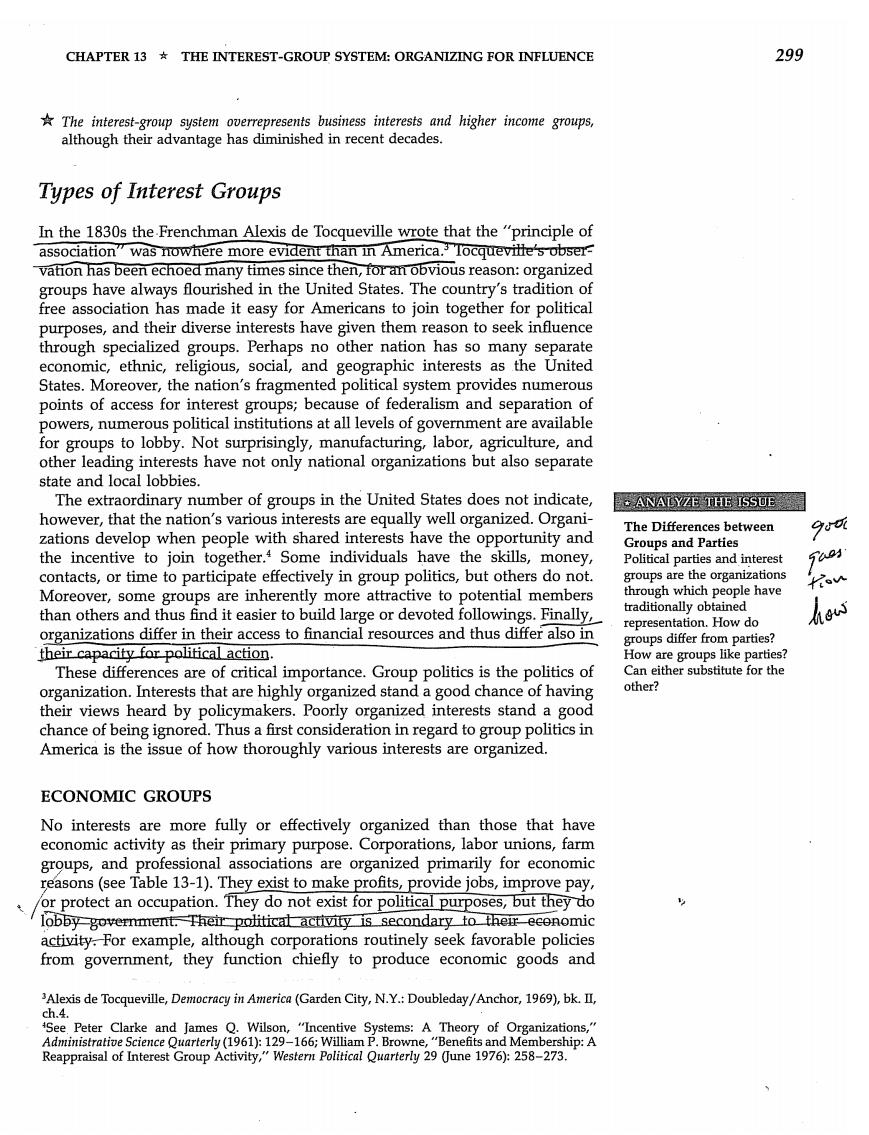
CHAPTER 13*THE INTEREST-GROUP SYSTEM:ORGANIZING FOR INFLUENCE 299 The interest-group system overrepresents business interests and higher income groups, although their advantage has diminished in recent decades. Types of Interest Groups In the 1830s the Frenchman Alexis de Tocqueville wrote that the"principle of association"was nowhere more evident than in America.Tocqueville's obser- vation has been echoed many times since then,for an obvious reason:organized groups have always flourished in the United States.The country's tradition of free association has made it easy for Americans to join together for political purposes,and their diverse interests have given them reason to seek influence through specialized groups.Perhaps no other nation has so many separate economic,ethnic,religious,social,and geographic interests as the United States.Moreover,the nation's fragmented political system provides numerous points of access for interest groups;because of federalism and separation of powers,numerous political institutions at all levels of government are available for groups to lobby.Not surprisingly,manufacturing,labor,agriculture,and other leading interests have not only national organizations but also separate state and local lobbies. The extraordinary number of groups in the United States does not indicate, ANALYZE THE ISSUE however,that the nation's various interests are equally well organized.Organi- The Differences between zations develop when people with shared interests have the opportunity and Groups and Parties the incentive to join together.Some individuals have the skills,money, Political parties and interest contacts,or time to participate effectively in group politics,but others do not. groups are the organizations Moreover,some groups are inherently more attractive to potential members through which people have than others and thus find it easier to build large or devoted followings.Finally, traditionally obtained organizations differ in their access to financial resources and thus differ also in representation.How do groups differ from parties? their capacity for political action. How are groups like parties? These differences are of critical importance.Group politics is the politics of Can either substitute for the organization.Interests that are highly organized stand a good chance of having other? their views heard by policymakers.Poorly organized interests stand a good chance of being ignored.Thus a first consideration in regard to group politics in America is the issue of how thoroughly various interests are organized. ECONOMIC GROUPS No interests are more fully or effectively organized than those that have economic activity as their primary purpose.Corporations,labor unions,farm groups,and professional associations are organized primarily for economic reasons(see Table 13-1).They exist to make profits,provide jobs,improve pay, or protect an occupation.They do not exist for political purposes,but they do lobby government.Their political activity is secondary to their eeonomic activity.For example,although corporations routinely seek favorable policies from government,they function chiefly to produce economic goods and Alexis de Tocqueville,Democracy in America(Garden City,N.Y.:Doubleday/Anchor,1969),bk.II, ch.4. See Peter Clarke and James Q.Wilson,"Incentive Systems:A Theory of Organizations," Administrative Science Quarterly(1961):129-166;William P.Browne,"Benefits and Membership:A Reappraisal of Interest Group Activity,"Western Political Quarterly 29 (June 1976):258-273
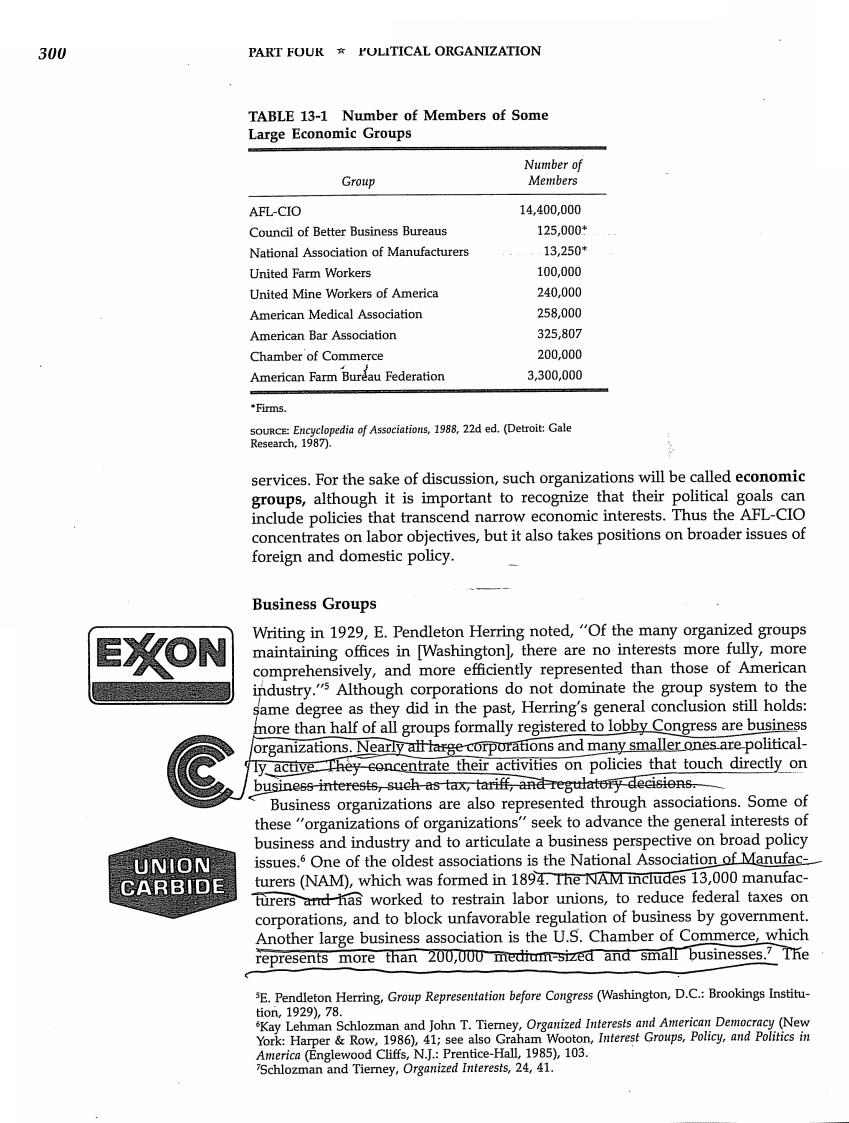
300 PART FOUR FULITICAL ORGANIZATION TABLE 13-1 Number of Members of Some Large Economic Groups Number of Group Members AFL-CIO 14,400,000 Council of Better Business Bureaus 125,000* National Association of Manufacturers 13,250* United Farm Workers 100,000 United Mine Workers of America 240,000 American Medical Association 258,000 American Bar Association 325,807 Chamber of Commerce 200,000 American Farm Bureau Federation 3,300,000 *Firms. SoURcg:Encyclopedia of Associations,1988,22d ed.(Detroit:Gale Research,1987刀 services.For the sake of discussion,such organizations will be called economic groups,although it is important to recognize that their political goals can include policies that transcend narrow economic interests.Thus the AFL-CIO concentrates on labor objectives,but it also takes positions on broader issues of foreign and domestic policy. Business Groups Writing in 1929,E.Pendleton Herring noted,"Of the many organized groups EXON maintaining offices in [Washington],there are no interests more fully,more comprehensively,and more efficiently represented than those of American industry."5 Although corporations do not dominate the group system to the same degree as they did in the past,Herring's general conclusion still holds: more than half of all groups formally registered to lobby Congress are business organizations.Nearly all large corporations and many smaller ones are political- ly active They eoncentrate their activities on policies that touch directly on business interests,such as tax,tariff,and regulatory decisions. Business organizations are also represented through associations.Some of these"organizations of organizations"seek to advance the general interests of business and industry and to articulate a business perspective on broad policy UNION issues.6 One of the oldest associations is the National Association of Manufac- CARBIDE turers (NAM),which was formed in 1894.The NAM includes 13,000 manufac- turers and has worked to restrain labor unions,to reduce federal taxes on corporations,and to block unfavorable regulation of business by government. Another large business association is the U.S.Chamber of Commerce,which represents more than 200,000 medium-sized and small businesses.?The E.Pendleton Herring,Group Representation before Congress(Washington,D.C.:Brookings Institu- tion,1929),78. Kay Lehman Schlozman and John T.Tierney,Organized Interests and American Democracy (New York:Harper Row,1986),41;see also Graham Wooton,Interest Groups,Policy,and Politics in America (Englewood Cliffs,N.J.:Prentice-Hall,1985),103. Schlozman and Tierney,Organized Interests,24,41